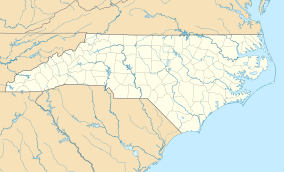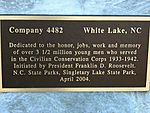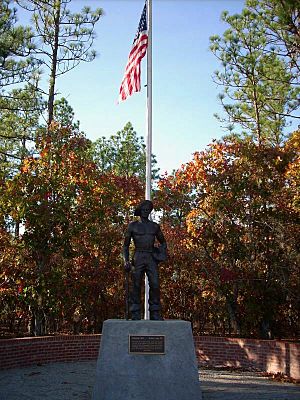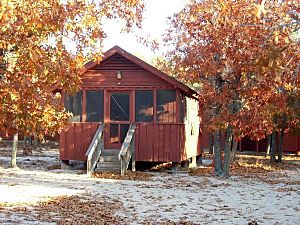Singletary Lake State Park facts for kids
Quick facts for kids Singletary Lake State Park |
|
|---|---|
|
IUCN Category III (Natural Monument)
|
|
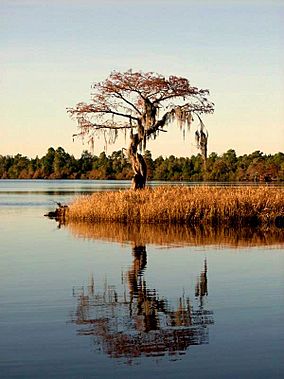
A cypress near the shore of Singletary Lake
|
|
| Location | Bladen, North Carolina, United States |
| Area | 1,221 acres (4.94 km2) |
| Elevation | 50 ft (15 m) |
| Established | 1939 |
| Named for | Singletary Lake |
| Governing body | North Carolina Division of Parks and Recreation |
Singletary Lake State Park is a special place in Bladen County, North Carolina. It's a state park that covers about 1,221 acres (4.94 km²). This area includes Singletary Lake, which is one of the biggest "Carolina bays."
The park is located southeast of Elizabethtown on North Carolina Highway 53. It's mainly used as a group camp. However, you can still visit for hiking, fishing, and enjoying nature all year round.
Contents
Park History: From Settlers to State Park
The area around Singletary Lake was first settled by early European colonists. Richard Singletary received land here in 1729 from the government of the Province of North Carolina. These early settlers cleared the land for farming and to get wood for ships and other products. Singletary Lake itself, being a Carolina bay, was not drained for farming like some other bays nearby.
Protecting the Lakes: State Ownership
In the 1800s, the state of North Carolina started to care about Singletary Lake and other Carolina bays. The North Carolina General Assembly stopped people from claiming private ownership of these lakes. Soon after, a law was passed. This law gave the state ownership of all lakes larger than 500 acres (2.02 km²) in Cumberland, Columbus, and Bladen Counties. This law helped create Jones Lake, Lake Waccamaw, and Singletary Lake state parks.
Land Changes and the Great Depression
Over time, industries like cotton, turpentine, and lumber grew in the Singletary Lake area. But this growth was too much for the land. The soil became less fertile, and most of the trees were cut down. Farmers could no longer grow enough crops, and many had to leave their homes.
During the Great Depression, a tough time in the 1930s, the National Park Service began buying land around Singletary Lake in 1936. This was part of a project to create recreational areas. Young men who were out of work joined the Civilian Conservation Corps (CCC). This group was started by President Franklin D. Roosevelt in 1933. The CCC built many of the facilities you see at Singletary Lake State Park today.
From 1936 to 1939, the CCC built the Singletary Recreation Center. They created an office, maintenance buildings, and fun facilities by the lake. The CCC also built a camp with ten cabins, a dining hall, a workshop, and a recreation hall.
Becoming a State Park
Singletary Lake State Park officially became a state park in 1939. At that time, the federal government handed over its management to the state. The cabins built by the CCC became Camp Ipecac. This camp is still used today by large groups like the Boy Scouts of America and 4-H. The park became fully state property in 1954.
Singletary Lake State Park has also helped people in other ways. In 1945, during floods of the Cape Fear River, the American Red Cross used it as a safe place for people who lost their homes. Soldiers training for World War II at nearby Camp Davis also used the park for special anti-aircraft training.
Ecology: The Unique Nature of Singletary Lake
Singletary Lake is one of many "Carolina bay" lakes. These lakes stretch along the Atlantic Coast from New Jersey to Florida. Scientists are still not completely sure how these lakes were formed.
What we do know is that Singletary Lake gets all its water from rain. No streams flow into it. The ground under and around the lake is made of sandy clay and sand. This land is lower than the surrounding area and doesn't drain water well, which helps create the lake.
Plants and Trees
A "bay forest" surrounds Singletary Lake. This forest has many bay trees like the loblolly, red bay, pond pine, and Atlantic white cedar. Closer to the ground, you'll find plants like huckleberry, leucothoe, gallberry, and pepperbush. In higher areas away from the lake, you can see turkey oak, blueberry, holly, and longleaf pine trees.
Animals and Wildlife
The forests at Singletary Lake State Park are home to many animals common in eastern woodlands. You might spot Wild turkeys, white-tailed deer, and rabbits. Wood ducks live on the lake. In the trees, you can see Red-cockaded woodpeckers, red-tailed hawks, and pileated woodpeckers. The park also has box turtles, fence lizards, southern toads, and carpenter frogs.
Turkey Oak Natural Area
The Turkey Oak Natural Area is a special 133-acre (0.54 km²) part of the park. It was set aside in the early 1960s by the Society of American Foresters. The goal is to keep this forest natural for scientific study and learning. This area is in the southeastern part of the park, in a bay bog and along a sand ridge.
Recreation: Fun at Singletary Lake
Singletary Lake State Park is different from other North Carolina state parks. It's mainly used by groups that book stays at Camp Ipecac or Camp Loblolly Bay. These are the park's two group camping facilities. If the camps are not in use, other visitors can still come to the park.
Group Camps: Camp Ipecac and Camp Loblolly Bay
Camp Ipecac was built in 1939 by the Resettlement Administration and the Civilian Conservation Corps during the Great Depression. It can house 92 campers in ten cabins. The camp is named after the Carolina ipecac, a plant used in old medicines. Camp Ipecac is open from April to October.
Camp Loblolly Bay was built in 1984 and can house 48 campers. It's more modern and is open all year. Both camps have a mess hall (dining area) and restrooms. For fun, the camps offer outdoor basketball courts, a beach volleyball court, and horseshoes. There are also charcoal grills and picnic tables for outdoor meals.
To use these camps, you need to be part of a recognized group of 20 or more people. Reservations are required.
Learning and Hiking
Local schools and community groups are invited to Singletary Lake State Park for educational programs. Park rangers lead these classes. They teach students, especially middle schoolers, about the unique environment of the Carolina Bays.
The Civilian Conservation Corps-Carolina Bay Loop Trail is a one-mile (0.6 km) hiking path. The CCC built this trail during the Great Depression. It goes along the shore of Singletary Lake. Then, it winds through the bay forest and another forest of longleaf pine and turkey oak trees.
Boating and Fishing
You can go boating and fishing on Singletary Lake. The lake's water is quite acidic. This is because of all the plants breaking down and peat building up on the lake bottom. The high acid levels mean there aren't many types of fish in the lake. So, fishing is limited.
Yellow perch are one type of fish that does well here. You can fish for them when the group camps are not in use. Campers and the public can bring their own boats to launch on the lake. All boats must have engines of 10 horsepower or less.
Nearby state parks
The following state parks are within 30 miles (48 km) of Singletary Lake State Park:
- Jones Lake State Park (Bladen County)
- Lake Waccamaw State Park (Columbus County)


